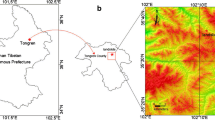Abstract
At approximately 2:00 p.m. (Beijing time) on August 6, 2019, the previously controlled Leidashi landslide was reactivated near group 7 of Zhangjiagou village, Jianyang County, Sichuan Province, China. The 2019 Leidashi landslide damaged two main roads and 44 antisliding piles and posed a threat to another main road. This landslide was a reactivation of the 2010 Leidashi landslide and had an accumulation zone of 2.2 × 106 m3. To explore the deformation characteristics and failure mechanism, detailed field investigations, unmanned aerial vehicle photogrammetry, airborne LiDAR surveys, borehole drilling and inclinometer installation were carried out, and the collected data were analyzed. The results show that the 2019 Leidashi landslide could be divided into main slipping zone and activated zone according to movement state, and the main slipping zone could also be divided into main scarp area, main deposit area, climbing area, uplift area, and local landslide area according to the local movement and geomorphic features. The rapidly increasing landslide thrust caused by short-term but continuous heavy rain caused the failure of the antisliding piles and ultimately reactivated the 2010 landslide.












Similar content being viewed by others
References
CNEC (2019) Historical earthquake inventory. http://www.ceic.ac.cn/history. Accessed 1 Sept 2019
Cui Y, Cheng D, Choi CE, Jin W, Lei Y, Kargel JS (2019) The cost of rapid and haphazard urbanization: lessons learned from the Freetown landslide disaster. Landslides 16(6):1167–1176
Dai FC, Lee CF, Wang SJ (1999) Analysis of rainstorm-induced slide-debris flows on natural terrain of Lantau Island, Hong Kong. Eng Geol 51:279–290
Glade T (1998) Establishing the frequency and magnitude of landslide-triggering rainstorm events in New Zealand. Environ Geol 35(2):160–174
Han N (2015) The research on the stability analysis and the prevention measurement of Leidashi landslide in Jianyang, Master Degree thesis, Southwest Jiaotong University. (In Chinese)
Hu G, Liu M, Chen N, Zhang X, Wu K, Khanal BR, Han D (2019) Real-time evacuation and failure mechanism of a giant soil landslide on 19 July 2018 in Yanyuan County, Sichuan Province, China. Landslides 16(6):1177–1187
Lee S, Pradhan B (2007) Landslide hazard mapping at Selangor, Malaysia using frequency ratio and logistic regression models. Landslides 4(1):33–41
Lee LM, Kassim A, Gofar N (2011) Performances of two instrumented laboratory models for the study of rainfall infiltration into unsaturated soils. Eng Geol 117(1–2):78–89
Li WC, Dai FC, Wei YQ, Wang ML, Min H, Lee LM (2016) Implication of subsurface flow on rainfall-induced landslide: a case study. Landslides 13(5):1109–1123
Lin F, Wu LZ, Huang RQ, Zhang H (2018) Formation and characteristics of the Xiaoba landslide in Fuquan, Guizhou, China. Landslides 15(4):669–681
Liu QQ, Jiang CL (2015) Geological features and stability evolution of the Leidashi landslide. Acta Geologica Sichuan 35(3):417–421 (In Chinese with English abstract)
Ouyang C, Zhao W, Xu Q, Peng D, Li W, Wang D, Hou S (2018) Failure mechanisms and characteristics of the 2016 catastrophic rockslide at Su village, Lishui, China. Landslides 15(7):1391–1400
Sichuan institute of Geological engineering investigation Group Co.LTD –SIGEIG (2019) The emergency rescue investigation report of 2019-08-06 Leidashi landslide at group 7 of Zhangjiagou village, Jiangyang county, Sichuan province. China [Landslide Report] (In Chinese)
Wang Y, Zhao B, Li J (2018) Mechanism of the catastrophic June 2017 landslide at Xinmo village, Songping river, Sichuan province, China. Landslides 15(2):333–345
Wu LZ, Huang RQ, Xu Q, Zhang LM, Li HL (2015) Analysis of physical testing of rainfall induced soil slope failures. Environ Earth Sci 73(12):8519–8531
Wu LZ, Zhang LM, Zhou Y, Li BE (2017a) Analysis of multi-phase coupled seepage and stability in anisotropic slopes under rainfall condition. Environ Earth Sci 76(14):469
Wu LZ, Zhou Y, Sun P, Shi JS, Liu GG, Bai LY (2017b) Laboratory characterization of rainfall-induced loess slope failure. Catena 150:1–8
Zhao L, Zuo S, Deng D, Han Z, Zhao B (2018) Development mechanism for the landslide at Xinlu Village, Chongqing, China. Landslides 15(10):2075–2081
Acknowledgments
We express our gratitude to Jiangpeng Qian and Tao Liu from the Sichuan Institute of Geological Engineering Investigation Group Co. Ltd. and Yang Liu from the Sichuan Provincial Department of Natural Resources for the borehole and monitoring data and to Chunhua Zhou from the Sichuan Meteorological Bureau for the rainfall data.
Funding
This research was financially supported by the National Key Research and Development Program of China (Grant No. 2018YFC1505402), the Fund for Creative Research Groups of China (Grant No. 41521002), the Fund for Youth Researcher of the Science and Technology Department of Sichuan Province of China (Grant No. 2017JQ0031), and the State Key Laboratory of Geohazard Prevention and Geoenvironment Protection Independent Research Project (Grant No. SKLGP2014Z004).
Author information
Authors and Affiliations
Corresponding authors
Rights and permissions
About this article
Cite this article
Li, W., Zhao, B., Xu, Q. et al. Deformation characteristics and failure mechanism of a reactivated landslide in Leidashi, Sichuan, China, on August 6, 2019: an emergency investigation report. Landslides 17, 1405–1413 (2020). https://doi.org/10.1007/s10346-020-01367-w
Received:
Accepted:
Published:
Issue Date:
DOI: https://doi.org/10.1007/s10346-020-01367-w




